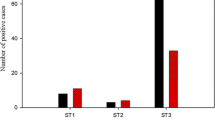Abstract
Blastocystis sp. is now recognized as one of the most common intestinal parasite in human fecal examinations. Recently, PCR-based diagnostic methods of Blastocystis infection using direct DNA extraction from fresh fecal samples with commercially available kits are reported. Several kits have been developed, but little has been done in comparing the detective sensitivity between PCR methods using the commercial kits. In this study, we compared the detective sensitivity among five commercially available kits (MagNA Pure LC DNA Isolation Kit I, Roche; QuickGene SP Kit DNA, FujiFilm; NucleoSpin Plant II, Macherey-Nagel; QIAamp DNA Stool Mini Kit, Qiagen; ZR Fecal DNA Kit, Zymo Research) and fecal culture method. In a preliminary test, the DNA isolated with two kits (FujiFilm and Macherey-Nagel) showed negative PCR, while the other three kits showed positive PCR. Then, DNA from 50 clinical samples that was Blastocystis-positive in the examination of fecal culture method were isolated with the three kits and 1.1 kbp SSU rRNA gene was detected with PCR. The positive rates of the three kits (Roche, Qiagen, and Zymo Research) were 10, 48 and 94%, respectively. The present study indicated that there is different detective sensitivity among the commercial kits, and fecal culture method is superior in detection rate and cost performance than DNA-elution kits for diagnosis of Blastocystis sp. subtypes.



Similar content being viewed by others

References
Dogruman-AI F, Dagci H, Yoshikawa H, Kurt Ö, Demirel M (2008) A possible link between subtype 2 and asymptomatic infections of Blastocystis hominis. Parasitol Res 103:685–689
Dogruman-AI F, Yoshikawa H, Kustimur S, Balaban N (2009) PCR-based subtyping of Blastocystis isolates from symptomatic and asymptomatic individuals in a major hospital in Ankara, Turkey. Parasitol Res 106:263–268
Eroglu F, Genc A, Elgun G, Koltas IS (2009) Identification of Blastocystis hominis isolates from asymptomatic and symptomatic patients by PCR. Parasitol Res 105:1589–1592
Eroglu F, Koltas IS (2010) Evaluation of the transmission mode of B. hominis by using PCR method. Parasitol Res 107:841–845
Hussein EM, Hussein AM, Eida MM, Atwa MM (2008) Pathophysiological variability of different genotypes of human Blastocystis hominis Egyptian isolates in experimentally infected rats. Parasitol Res 102:853–860
Leelayoova S, Taamasri P, Rangsin R, Naaglor T, Thathaisong U, Mungthin M (2002) In-vitro cultivation: a sensitive method for detecting Blastocystis hominis. Ann Trop Med Parasitol 96:803–807
Jones MS, Whipps CM, Ganac RD, Hudson NR, Boroom K (2009) Association of Blastocystis subtype 3 and 1 with patients from an Oregon community presenting with chronic gastrointestinal illness. Parasitol Res 104:341–345
Özyurt M, Kurt Ö, Mølbak K, Nielsen HV, Haznedaroglu T, Stensvold CR (2008) Molecular epidemiology of Blastocystis infections in Turkey. Parasitol Int 57:300–306
Parkar U, Traub RJ, Kumar S, Mungthin M, Vitali S, Leelayoova S, Morris K, Thompson RCA (2007) Direct characterization of Blastocystis from faeces by PCR and evidence of zoonotic potential. Parasitol 134:359–367
Parker U, Traub RJ, Vitali S, Elliot A, Levecke B, Robertson I, Geurden T, Steele J, Drake B, Thompson RCA (2010) Molecular characterization of Blastocystis isolates from zoo animals and their animal-keepers. Vet Parasitol 169:8–17
Rene BA, Stensvold CR, Badsberg JH, Nielsen HV (2009) Subtype analysis of Blastocystis isolates from Blastocystis cyst excreting patients. Am J Trop Med Hyg 80:588–592
Souppart L, Sanciu G, Cian A, Wawrzyniak I, Delbac F, Capron M, Dei-Cas E, Boorom K, Delhaes L, Viscogliosi E (2009) Molecular epidemiology of human Blastocystis isolates in France. Parasitol Res 105:413–421
Suresh K, Smith H (2004) Comparison of methods for detecting Blastocystis hominis. Eur J Clin Microbiol Infect Dis 23:509–511
Stensvold R, Brillowska-Dabrowska A, Nielsen HV, Arendrup MC (2006) Detection of Blastocystis hominis in unpreserved stool specimens by using polymerase chain reaction. J Parasitol 92:1081–1087
Stensvold CR, Arendrup MC, Jespersgaard C, Mølbak K, Nielsen HV (2007) Detecting Blastocystis using parasitologic and DNA-based methods: a comparative study. Diagn Microbiol Infect Dis 59:303–307
Stensvold CR, Alfellani MA, Nørskov-Lauritsen S, Prip K, Victory EL, Maddox C, Nielsen HV, Clark CG (2009) Subtype distribution of Blastocystis isolates from synanthropic and zoo animals and identification of a new subtype. Int J Parasitol 39:473–479
Tan TC, Suresh KG, Smith HV (2008) Phenotypic and genotypic characterization of Blastocystis hominis isolates implicates subtype 3 as a subtype with pathogenic potential. Parasitol Res 104:85–93
Termmathurapoj S, Leelayoova S, Aimpun P, Thathaisong U, Nimmanon T, Taamasri P, Mungthin M (2004) The usefulness of short-term in vitro cultivation for the detection and molecular study of Blastocystis hominis in stool specimens. Parasitol Res 93:445–447
Wong KHS, Ng GC, Lin RTP, Yoshikawa H, Taylor MB, Tan KSW (2008) Predominance of subtype 3 among Blastocystis isolates from a major hospital in Singapore. Parasitol Res 102:663–670
Yan Y, Su S, Lai R, Liao H, Ye J, Li X, Luo X, Chen G (2006) Genetic variability of Blastocystis hominis isolates in China. Parasitol Res 99:597–601
Yan Y, Su S, Ye J, Lai X, Lai R, Liao H, Chen G, Zhang R, Hou Z, Luo X (2007) Blastocystis sp. subtype 5: a possibly zoonotic genotype. Parasitol Res 101:1527–1532
Yoshikawa H (2011) Blastocystis. In: Liu D (ed) Molecular detection of human parasitic pathogens. CRC, Boca Raton, FL, USA (in press)
Yoshikawa H, Wu Z, Nagano I, Takahashi Y (2003) Molecular comparative studies among Blastocystis isolates obtained from humans and animals. J Parasitol 89:585–594
Yoshikawa H, Wu Z, Kimata I, Iseki M, Ali IKMD, Hossain MB, Zaman V, Haque R, Takahashi Y (2004) Polymerase chain reaction-based genotype classification among human Blastocystis hominis populations isolated from different countries. Parasitol Res 92:22–29
Author information
Authors and Affiliations
Corresponding author
Additional information
An erratum to this article can be found at http://dx.doi.org/10.1007/s00436-011-2742-4
Rights and permissions
About this article
Cite this article
Yoshikawa, H., Dogruman-AI, F., Turk, S. et al. Evaluation of DNA extraction kits for molecular diagnosis of human Blastocystis subtypes from fecal samples. Parasitol Res 109, 1045–1050 (2011). https://doi.org/10.1007/s00436-011-2342-3
Received:
Accepted:
Published:
Issue Date:
DOI: https://doi.org/10.1007/s00436-011-2342-3



